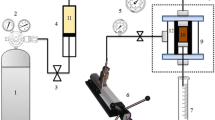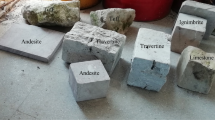Abstract
Certain drilling problems are frequently observed during different types of drilling (e.g. geothermal, oil, geotechnical). In order to maintain the stability of boreholes, analysis of the essential parameters affecting their stability, including induced post-drilling stresses, the geomechanical properties of the rocks encountered during drilling and the type of drilling fluid used, should be considered. Well pressure, which is a function of the density of the drilling fluid, should be kept at a level that will not create shear- or tensile-type failure around the borehole walls; however, the mechanical properties of rocks are not constant and can be varied due to the interaction between drilling fluid and rock materials especially for clay-bearing rocks. Despite being aware of these factors, to date, no comprehensive study has been conducted on these issues. In order to overcome these shortcomings, the variations in mechanical properties of two clay-bearing sediments, which were saturated with different types of drilling fluids that are widely used in drilling practices, were investigated. By considering the obtained geomechanical properties, the effect of drilling fluids was compared and evaluated in terms of degradation of mechanical properties. As the occurrence of excess pore pressures that can develop under undrained conditions around a borehole is essential to borehole stability, the distribution of excess pore pressures and plastic deformations was also investigated by a finite element-based borehole simulation under drained and undrained conditions. By considering the results of experimental and numerical studies, some recommendations were presented for understanding wellbore stability.






Similar content being viewed by others
References
Aadnoy BS (1996) Modern well design. A. A. Balkema Publishers, Netherland
Aoki T, Tan CP, Bamford WE (1993) Effects of deformation and strength anisotropy on borehole failures in saturated shales. Int J Rock Mech Min Sci Geomech Abstr 30(7):1031–1034
API Specification 13A (2010) Specifications for drilling fluid materials, 18th edn. American Petroleum Institute, Washington, DC, p 130
Chen G, Chenevert MA, Sharma MM, Yu M (2003) A study of wellbore stability in shales including poroelastic, chemical, and thermal effects. J Pet Sci Eng 38:167–176
Dönmez M, Akçay AA, Türkecan A (2014) İzmir-K 18 Paftası, 1:100.000 Ölçekli Türkiye Jeoloji Haritaları, No:213, MTA Jeoloji Etütleri Dairesi, Ankara
Dyke CG, Dobereiner L (1991) Evaluating the strength and deformability of sandstones. Q J Eng Geol 24:123–134
Ergüler ZA, Ulusay R (2009) Water-induced variations in mechanical properties of clay-bearing rocks. Int J Rock Mech Min Sci 46(2):355–370
Ewy RT, Bovberg CA, Stankovich RJ (2008) Shale triaxial strength alteration due to brine exposure. The 42nd U.S. Rock Mechanics Symposium (USRMS), 29 June-2 July, San Francisco, California
Gerçek, H. (2007). Poisson’s ratio values for rocks. Int J Rock Mech Min Sci 44(1):1–13
Goodman RE (1989) Introduction to rock mechanics. Wiley, NewYork
Grillet AM, Wyatt NB, Gloe LM (2012) Polymer gel rheology and adhesion. In: De Vicente J (ed) Rheology, IntechOpen. https://doi.org/10.5772/2065
Gündoğdu MN (1982) Geological, mineralogical and geochemical investigatoin of the Neogene aged Bigadic sedimentary basin. PhD Thesis, Geological Engineering Department, Hacettepe University, Ankara (in Turkish)
Hawkins AB (1998) Aspects of rock strength. Bull Eng Geol Environ 57:17–30
He S, Liang L, Zeng Y, Ding Y, Lin Y, Liu X (2016) The influence of water-based drilling fluid on mechanical property of shale and the wellbore stability. Petroleum 2(1):61–66
ISRM (2007) The complete ISRM suggested methods for rock characterization, testing and monitoring: 1974-2006. Suggested methods prepared by the commission on testing methods. In: Ulusay R, Hudson JA (eds) Compilation arranged by the ISRM Turkish National Group. ISRM, Ankara
Javalagi S and Singireddy SR (2012) Hydraulic fluid properties and its influence on system performance. Master’s degree project. Division of fluid and mechatronic systems department of management and engineering. LIU-IEI-TEK-A--12/01284—SE
Karakul H, Ulusay R (2013) Empirical correlations for predicting strength properties of rocks from P-wave velocity under different degrees of saturation. Rock Mech Rock Eng 46(5):981–999
Lashkaripour GR (2002) Predicting mechanical properties of mudrock from index parameters. Bull Eng Geol Environ 61:73–77
Liu X, Zeng W, Liang L, Xiong J (2016) Experimental study on hydration damage mechanism of shale from the Longmaxi formation in southern Sichuan Basin, China. Petroleum 2:54–60
Liu J, Feng Q, Wang Y, Bai Y, Wei J, Song Z (2017) The effect of polymer-fiber stabilization on the unconfined compressive strength and shear strength of sand. Adv Mater Sci Eng Article ID 2370763, 9 pages
Mavko G, Mukerji T, Dvorkin J (2009) The rock physics handbook. Cambridge University Press, New York
Mkpoikana R, Dosunmu A, Eme C (2015) Prevention of shale instability by optimizing drilling fluid performance. SPE Nigeria Annual International Conference and Exhibition, 4-6 August, Lagos, Nigeria
Nmebgu CGJ, Ohazurulike LV (2014) Wellbore instability in oil well drilling: a review. Int J Eng Res Dev 10(5):11–20
Pasic B, Medimurec NG, Matanovic D (2007) Wellbore instability: causes and consequences. Rudarsko-geološko-naftni zbornik 19:87–98
Plaxis (2016) PLAXIS material models manual. Plaxis, Delft
Shakib JT, Jalalifar H, Akhgarian E (2013) Wellbore stability in shale formation using analytical and numerical simulation. J Chem Petrol Eng 47(1):51–60
Shilko EV, Dimaki AV, Psakhie SG (2018) Strength of shear bands in fluidsaturated rocks: a nonlinear effect of competition between dilation and fluid flow. Sci Rep 8:1428. https://doi.org/10.1038/s41598-018-19843-8
Skempton AW (1954) The pore-pressure coefficients A and B. Geotechnique 4:143–147
Torok A, Vasarhelyi B (2010) The influence of fabric and water content on selected rock mechanical parameters of travertine, examples from Hungary. Eng Geol 115:237–245
Vasarhelyi B (2005) Statistical analysis of the influence of water content on the strength of the Miocene limestone. Rock Mech Rock Eng 38(1):69–76
Vipulanandan C, Mohammed AS (2014) Hyperbolic rheological model with shear stress limit for acrylamide polymer modified bentonite drilling muds. J Pet Sci Eng 122:38–47
Wong LNY, Maruvanchery V, Liu G (2016) Water effects on rock strength and stiffness degradation. Acta Geotech 11(4):713–737
Yan C, Deng J, Yu B (2013) Wellbore stability in oil and gas drilling with chemical-mechanical coupling. Sci World J 2013:720271
Yılmaz I (2010) Influence of water content on the strength and deformability of gypsum. Int J Rock Mech Min Sci 47(2):342–347
Yu B, Yan C, Nie Z (2013) Chemical effect on wellbore instability of Nahr Umr shale. Sci World J 2013:931034
Zhang J (2017) Effects of porosity and permeability on invasion depth during drilling mud-filtrate invading into a reservoir dynamically. Adv Comput Sci Res 76:203–206
Zosel A (1985) Adhesion and tack of polymers: influence of mechanical properties and surface tensions. Colloid Polym Sci 263:541–553 ISSN 0303-402X
Acknowledgments
The author is grateful to Assistant Professor Ali Ettehadi and Osman Ünal (Research assistant) for their kind help with the viscosity measurements of the drilling fluids, and to Naci Sertuğ Şenol (Graduate student) for his help in rock sampling studies.
Funding
This work was supported by the Scientific Research Project Coordination Unit (Project No. 2016-GAP-MÜMF-0004) of İzmir Kâtip Çelebi University.
Author information
Authors and Affiliations
Corresponding author
Rights and permissions
About this article
Cite this article
Karakul, H. Effects of drilling fluids on the strength properties of clay-bearing rocks. Arab J Geosci 11, 450 (2018). https://doi.org/10.1007/s12517-018-3816-8
Received:
Accepted:
Published:
DOI: https://doi.org/10.1007/s12517-018-3816-8




